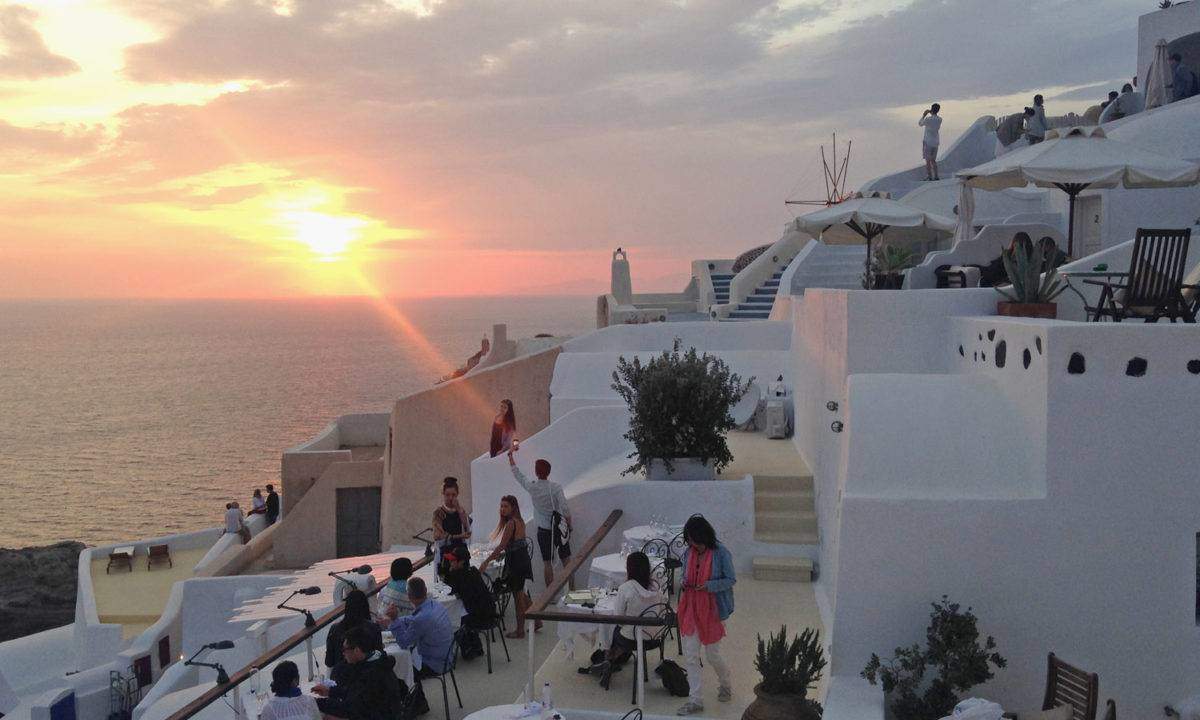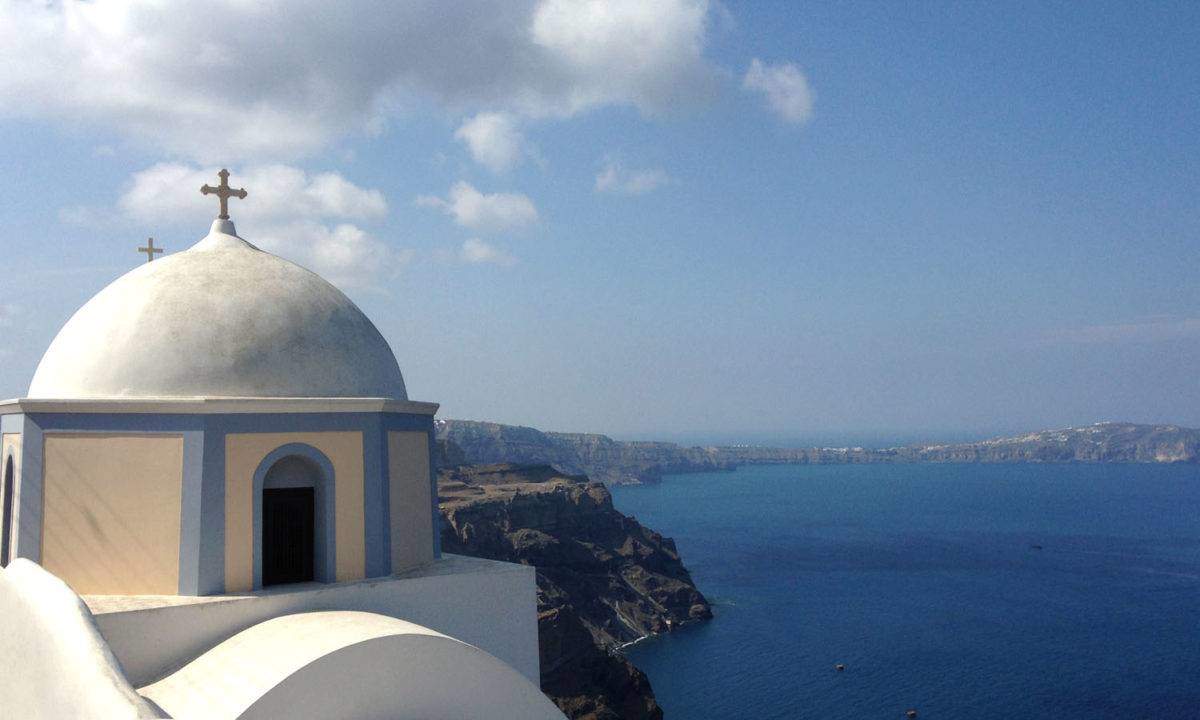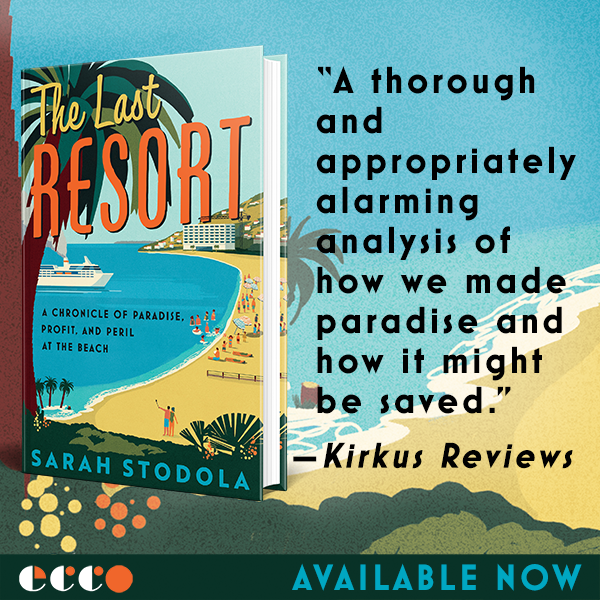Arriving by boat to Santorini, the theatrical C-shaped island in Greece’s Aegean Sea, means first entering the strange purgatory of the port, which of course sits at sea level, 1,200 feet below the villages atop the cliffs that everyone is here to see. Our boat pulled in in the early afternoon of a sunny but hazy day. Even before hitting land, we could feel the collective goodwill draining away. After, people outnumbered the services they were seeking out. We disembarked to discover that our pre-booked ride in a passenger van had been oversold. We were told to wait. We sat at an outdoor café but did not order anything. There is no sense of leisure in the dusty, chaotic, unscrupulous port, only a hammering desire to get out of it.
We called our hotel, through whom the van had been booked. Eventually, a driver in a car fetched us and we began the next leg of the trip. The drive is at first spectacular, and we gaped out the window as we rose above the Aegean. After reaching the summit south of the capital village of Fira, though, Santorini flattens out. Here, it smacks of slapdash development. It reminded me most of certain forgotten pockets of Mexico I’ve driven through, barren and mismatched, with an undercurrent of hassle. The traffic clogged, we moved at a crawl along a parched, frenetic landscape. I wanted to leave before I’d even arrived.
It makes sense to stop here and make note of the Santorini I’d been hoping for, which was to its disadvantage informed by the place we arrived to it from. My boyfriend and I had just spent five days on the nearby island of Folegandros. Upon arrival there on a boat from Athens, a van from our hotel greeted us immediately, whisked us to our room three minutes away. The hotel sat atop a steep terraced hill that sloped straight down into the sea. We asked how old those terraces were, and the proprietor of the hotel told us in all earnestness that they are as old as time itself. Every morning a herd of goats made its way down the hill, terrace by terrace, and every late afternoon climbed back up. (You should stay at this hotel, it’s magnificent.)
From our own small terrace, distant blue waters subjugated our line of vision. A couple of times a day, we made the one-minute walk into the main village, Chora, where whitewashed houses and flaming pink bougainvillea line small walkways that open onto a series of squares. In one of them, village men of a certain age gathered at a particular café every morning, ordered coffee, and watched nothing much happen. There’s one bakery and one ice cream shop. Three or four bars. Maybe 10 excellent, inexpensive restaurants. We got to know the village cats. There are no cars in Chora. Daily life flopped along here in the most pleasant way.



Automobile traffic was scarce all over the island, and we rented scooters to get ourselves from one end to the other. At one spot, we turned off the main road, descended, and found ourselves in a lovely bay with a perfect beach. We parked the scooters and from there, hiked over hills to another beach, this one accessible only by foot or boat. Further down the main road, there’s a scattered village where only locals live, and just beyond it, a restaurant serving what is known to be the best version of Folegandros’ signature pasta, matsata.
We’d booked two nights, but stayed four in the end—early June affords the shoulder-season luxury of spontaneity. We daydreamed of living there. When we left Folegandros, it was with regret, driven only by a sense of obligation to see other, more celebrated places before returning to New York.
Santorini would have made me happy had it been Folegandros, only more so.
It was in fact more so, but of the wrong things.
It makes sense to stop here again and observe the truly remarkable geography that comprises Santorini. Those 1,200-foot cliffs almost completely encircle a 32-square-mile bay that makes cruise ships look like toys, at the center of which rises the active volcano that once upon a time in history exploded a vast island, leaving only the rim. Villages simultaneously stand in place and drip down the cliffs like a Slinky. From any spot in any of them, one’s eyes meet with views that suffer only from seeming too spectacular to be real. One imagines sitting in place, staring at them tranquilly for days. Especially if you’ve only seen pictures of Santorini, you might believe that you could relax there.
You can’t, because people are everywhere, shops are everywhere catering to them, brides are everywhere posing for their wedding photographers, tourists are stopping at every turn to capture a perfect shot. The taking of photos is central to the Santorini experience. It’s easy, in fact, to use a trip to Santorini to disguise a general lack of a photographic eye. The island takes a good picture, with or without your talent, and in those pictures the crowds and the exasperation generally lie just outside the frame.
Saturini, we took to calling it, as we navigated pedestrian-cramped streets, stopping and starting for groups of tourists as they weighed their options, failing to find an open table at any of the bars, starting to take the stress out on each other.
Upon arrival to our hotel in the village of Imerovigli, two late-middle-aged American women greeted us from their wine-drinking situation on the terrace in front of our room. “Have you ever seen anything so glorious?” one asked, not exactly rhetorically, for I was expected to answer in the gushing affirmative. Those two women, plus their posse of six or so, sat out on the terrace in the early evenings and filled the sea air with a middle-management patter that betrayed the whole thing they were pursuing here.
On our first night on Santorini, which was also our penultimate, we headed to Oia, a village where the sunset has become famous to a fault. Oia is the village you picture when you think of the Greek islands, especially if you have never been to them—it is sometimes said to be the world’s most photographed village. Oia is dramatic and smothering and maintained to surreal standards. The island’s entire temporary population seems to crowd into it to watch the sunset; a deserving draw, but no more so than the sunset from our hotel terrace in Imerovigli.



After dinner that night (the food is generally twice as expensive and half as good as on Folegandros), we had a wander and ended up in a shop where we bought gifts for loved ones back home, and while my boyfriend was at the cash register, I discovered a print of a photo of Oia taken in 1950, which I studied for some time and eventually purchased. The village’s bones are the same, but the surface is rougher. These buildings look lived in, as opposed to today’s version, which would raise no eyebrows if presented as a replica at a new Vegas casino called the Aegean. The church domes were white, not the familiar blue of today. It is an image of authenticity. The photo now sits on our mantel at home, a souvenir of a place that actually, I did not visit.
How Santorini Happened
Santorini’s modern era can be said to have started a few years after that photo was taken, in 1956, when an earthquake devastated the island, especially Oia, leveling scores of buildings and driving residents away in droves. In the early 20th century, Santorini was still thriving as a wine producer, pumice exporter, niche agricultural producer, and center for the commercial shipping trade. But with its traditional industries already in decline by mid-century, the earthquake cleared the way on Santorini for a tourism industry that would erupt in the following decades, thanks also to an emergent global middle class with disposable income and affordable air travel.
I spent a morning recently poring over articles about Santorini in the New York Times’s online archives, trying to get a sense for what Santorini was like in the 1970’s, the 1980’s, and for when the pivotal moment arrived—when Santorini transformed from a Greek island that travelers sometimes visited into a tourist center that occasionally offered a whiff of Greek culture.
I found that Greek cruises were a thing already in the 1960’s, but retained a sense of the exotic. I found that the Santorini airport opened in 1972. Speaking of Oia that year, the Times had this to say:
The influx of tourists, both Greek and foreign, has…been large enough to bring about the establishment of perhaps a dozen restaurants, some of them excellent, a bar and a boutique, but tourism has not yet been substantial enough to submerge the habits and customs of the islanders.
Four years later, in 1976, a short article appeared with the headline, “Restored Villages in Greece,” about a government program to bring deserted villages up to a standard that would attract tourism. One of the villages targeted? Oia. At that time there was still just a single “main” hotel on Santorini, the Atlantis, which opened, appropriately, in 1956.
In 1984, the Times published a piece in its Travel section examining the result of this program. Even at this late date, it goes so far as to refer to places like Oia as “hinterland.” The program seems to be working, travelers are coming, but the author still speaks of the relaxation that came to him in Oia, and the locals he observed going about their lives.
In a 1986 article, I found the first reference to the “hordes” visiting Santorini. That same article describes it thusly (it is a piece, incidentally, about the joys of Folegandros):
[Santorini’s] exceptional beauty was not enough to make up for a pollution of discos, fast-food restaurants, hotels, gift shops and the throngs of tourists that these installations require.
Here is the pivotal point.
Sometime in the mid-1980s the crowds became too much. This evolution in part reflects the rise in tourism to Greece overall in the preceding years—in 1965, fewer than a million tourists traveled there, while by 1985 that number had exploded to 7 million. In 1950, the year of the photo on my mantel, a mere 33,000 foreigners traveled to Greece.[i]
Still, I talked to one friend after my return who visited Santorini in the 1990s, and another who visited in the early 2000s with her husband. Both remembered a place easily enjoyed. A look at what’s happened since 1990 indeed shows that while it got bad in the 1980s, it didn’t let up when they ended, and that what seemed teeming in 1985 might appear tranquil today. In 1990 there were fewer than 22,000 hotel beds in the Cyclades islands, of which Santorini and Mykonos are the most visited by far, according to data provided to the Association of Greek Tourism Enterprises (SETE) by the Hellenic Chamber of Hotels. By 2000 that number had risen to over 36,000. By 2013, the most recent numbers available, there were nearly 49,000—the Cyclades house well over twice as many hotel rooms now as in 1990. It’s likely that were Santorini’s data isolated, the number would be higher.
A Better Way?
Greece courted this, of course. The government saw its beautiful, abandoned islands and gambled that people could be drawn to them. The gamble worked, and today tourism accounts for 18 percent of Greece’s GDP, with one out of every five Greek workers thus employed. There is an argument to be made, then, that Greece orchestrated present-day Santorini, sacrificed it and a few of its other most idyllic islands for its greater good. If we are talking about an entire nation’s well-being, the sacrifice seems like a reasonable one.
But did the transformation of places like Santorini have to be so thorough? Is there a way to bring tourism about but manage it well, cultivating it and containing it simultaneously?
The few studies on Greek tourism that do exist focus on infrastructure needs and sustainability as Greece pursues further growth of this sector. They rightly conclude that the current infrastructure is inadequate, especially on the islands, and that environmental degradation needs to be addressed. Omitted from these studies is how it could have been different. Also overlooked is the experience of the traveler. Of course, both infrastructure and sustainability are major issues on Santorini today, and influence the traveler’s satisfaction—were public transportation options better, for example, we may not have felt so oppressed every time we wanted to leave our one tiny village. But there’s a quality of life assessment to be made outside of infrastructure, as well.



It’s not all bad on Santorini. Miraculously, the mega-resorts have been kept away—one look at the cliff villages there makes clear that the geography isn’t right for a hotel with more than 20 or so rooms. This means locally owned small hotels that benefit the local economy thrive here. There may be too many of them, but to limit their numbers would have been to turn away money. For a country in a perennially thorny economic situation, that’s a tricky proposition.
Additionally, plenty of vacationers seem to love the energy of Santorini, even in its crowded state today. All those hotel rooms do not stand empty during the high season. For a certain kind of vacationer, Santorini was done right.
Back on Folegrandros, though, the owners of our hotel told us that the island has placed a moratorium on new hotels. I haven’t been able to confirm this, but if it’s true, then it would appear that not only have lessons been learned from the Santorini experiment, but other islands are taking active measures as a result. Santorini has happened, there’s no going back. But not every island has to follow suit in order to be prosperous.
Santorini has happened. I fit into its sunset milieu that night in Oia via a very expensive restaurant with a very choice view of the sunset. From that perch, paying handsomely for the privilege of an arm’s length of space in every direction, it was possible finally to stop, to breathe, and to not only notice but appreciate my surroundings. As if on cue, a young Chinese woman in a white muslin dress posed in front of the sunset in the middle distance, her boyfriend, or maybe just an admirer, snapping an endless parade of shots. The whitewashed village behind her obliged in providing an ideal set. The sun descended further, dinner boats arrived down below and dropped anchor. The woman smiled into the camera, demurely, lowering her gaze, with a flick of her wrist encouraged her skirt to flutter in the breeze. She was here, this was her holiday. She was capturing it for posterity, to remember later the places she’d been. But what is the subject in such a picture? It would be hard to conclude that the subject is Greece.
-by Sarah Stodola
[i] http://www.researchgate.net/publication/30930408_Tourism_in_Greece_Strategic_analysis_and_challenges






